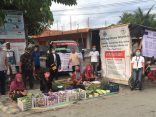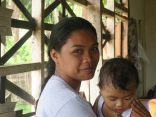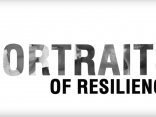By Anjo Bacarisas
In photo: Rogie Dagami, member of the bayanihan team reconstructing shelters in Tabontabon, Leyte, preparing meals for his mother and himself.
Twenty-eight year old Rogie Dagami has had polio since he was a three-month old baby. He worked as a self-employed tailor repairing jeans and shirts, but barely made enough income to support himself and his fifty-five year old mother, Imelda. In spite of his struggles, Rogie is proud to be part of the bayanihan team that helps rebuild the neighborhood houses that had been destroyed by Typhoon Yolanda.
By Anjo Bacarisas
In photo: Rogie Dagami, member of the bayanihan team reconstructing shelters in Tabon-Tabon, Leyte, preparing meals for his mother and himself.
Twenty-eight year old Rogie Dagami has had polio since he was a three-month old baby. He worked as a self-employed tailor repairing jeans and shirts, but barely made enough income to support himself and his fifty-five year old mother, Imelda. In spite of his struggles, Rogie is proud to be part of the bayanihan team that helps rebuild the neighborhood houses that had been destroyed by Typhoon Yolanda.
Death and loss
Rogie and Imelda lived in Barangay Mohon in the municipality of Tabon-Tabon, a rural town far from the provincial capitol. Yolanda’s onslaught of strong winds and rain fell down a tree destroying their house and fatally injuring Rogie’s father. His father, the bread winner of the family, died two weeks after in a hospital in Manila. This tragic event made their lives miserable, like the thousands of families affected by the typhoon disaster.
Rogie’s father earns a meager three dollars ($3.00) per day as a farm laborer in the villages nearby. Due to the incident, his mother was compelled to borrow money from lending institutions, using their small parcel of farm land as collateral, to pay for the hospitalization of her husband. This left them unable to adequately meet their daily needs.
Imelda added that the farm lands in the area are owned by only three rich families, while most of the families in the barangay are poor farm workers whose incomes are not enough to meet their basic needs, let alone recover from the disaster.
“I can’t look for a job because my son has polio and I can’t leave him alone,” Imelda said. Rogie’s condition does not allow him to do hard labor, and he cannot land higher-paying jobs as he did not finish secondary and tertiary education.
Despite all these, Imelda still firmly said, “But we are still hoping for the best.”
Depressed community
After the typhoon, around seventy-three households in the village sought refuge in makeshift shanties built from the rubbles found nearby. Both parents and children are always in fear of another storm, as they are aware that their shanties could not withstand even a weak storm.
Fe Tenagra, a 44-year old mother of five, mentioned that their makeshift shanties would become so hot during the day, and at night it would become so cold. As a result, the children in the community appear to be sad —they do not have the energy to play with other kids as they lack sleep due to the condition of their homes.
“We can’t even call it home,” said Tenagra in reference to their makeshift shanties.
Relieved
“If we did not receive house repair kits, it would take maybe a year before we can rebuild our homes,” Imelda said. She believes that if not for shelter support given to them, they would still be looking for employment opportunities that would give them the capacity to buy shelter materials and tools. Assistance and Cooperation for Community Resilience and Development (ACCORD), in partnership with CARE Philippines, provided shelter assistance to poor households with houses damaged by the storm. ACCORD provided shelter repair kits and trained the community on Build Back Safer techniques so they can rebuild stronger houses to protect their families.
“Instead of using our hard-earned money to buy materials, we used it to buy food and other needs,” Tenagra said, adding that the repair materials gave them financial leeway to afford their other needs.
Imelda added that livable houses are a basic need for the community because everyone in the community has families—they have children that need secure homes. She said, “We can now sleep tight at night. It is a lot comfortable compared to our shanties. The community has changed.” She added that parents and their children now seem to have renewed vigor in their day-to-day living.
United and resilient
Barangay official Nancy Bascon, 29 years old, said she is happy to see the GI Sheets of their new houses glimmer in the middle of the afternoon sun. She also observed that the community has changed after Yolanda – they became more united and cohesive in their activities
“When ACCORD provided shelter support, the bayanihan practice was revived in building back their homes and fostered unity among families in our village,” Bascon said.
Bayanihan or pintakasi (mutual aid) is a concept applied by ACCORD in beneficiary communities to foster unity among villagers, and to make building or repairing their homes faster. Villagers are asked to group themselves and help each other in the repair process.
Polio-stricken Rogie did not let his disability become a hindrance and strived to become an effective member of the bayanihan group to the limits of his capacity.“Through bayanihan, I helped my neighbors rebuild their homes,” he said, adding that he helped in sawing lumber for repairs and installing roofs.
He added that he is confident that the houses they rebuilt are more resilient than before, by using the building back safer techniques introduced to them by ACCORD staff during a community general assembly. When asked what are the tips to make their houses safer, he enumerated the basic points correctly – roofing, bracing and connections.
These shelters designed through bayanihan are designed to withstand typhoons that are not as strong as Yolanda. It is important to note that even concrete houses with metal braces were completely or partially devastated by Yolanda, deeming them unfit to shelter families.
While the menfolk were busy rebuilding homes, the women played a special role in the process: preparing snacks for those involved in bayanihan and handing over materials to the carpenters to hasten repairs. Women have also begun to participate in farming aside from remaining in their houses to rear children, do domestic chores and pass time in idle chitchat,” Bascon said. She noted, “We have nothing to depend on in times like these but ourselves.”
Hopes are up
Amidst hardships, the community’s hopes in achieving their dreams and aspirations are still high. Imelda shared, “At present I’m still trying to figure out ways to generate income for the family,” while adding that her son needs a new set of crutches.
Tenagra wanted to see her children finish secondary education and graduate from college. She said that if her children can finish college and find decent-paying job, the family income will surely be augmented. At present, Tenagra said that they cannot even spare money to afford medication for her schistosomiasis infection.
However, aid is imminent. Their barangay was selected as one of the beneficiaries of ACCORD livelihood support. People like Rogie will be able to continue their efforts in helping their neighbors, this time not with nails and GI sheets, but with livelihood support and stronger community relationships.
ACCORD's interventions in Tabon-Tabon, as well as in the other Leyte municipalities of Dagami, Pastrana, Tolosa and La Paz, have been made possible through the support of the Canadian Department of Foreign Affairs, Trade and Development (DFATD).




